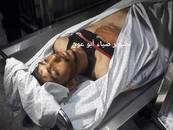9 oct 2018
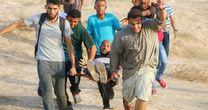
At least four Palestinians were injured on Tuesday evening when the Israeli occupation forces opened fire at peaceful protesters east of Deir al-Balah city in the central Gaza Strip.
The PIC reporter said that the Israeli forces heavily fired live ammunition and teargas canisters at dozens of Palestinian protesters east of Deir al-Balah.
Some of the protesters choked on teargas and were treated in the field, while others, who suffered live bullet wounds, were transferred to a local hospital for treatment.
Palestinian youths in Deir al-Balah march in the evening every Tuesday at the border fence. Night demonstrations have been for weeks a major part of the Great March of Return which started on 30 March.
The PIC reporter said that the Israeli forces heavily fired live ammunition and teargas canisters at dozens of Palestinian protesters east of Deir al-Balah.
Some of the protesters choked on teargas and were treated in the field, while others, who suffered live bullet wounds, were transferred to a local hospital for treatment.
Palestinian youths in Deir al-Balah march in the evening every Tuesday at the border fence. Night demonstrations have been for weeks a major part of the Great March of Return which started on 30 March.
8 oct 2018
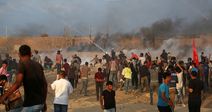
At least 29 Palestinians were injured Monday evening as Israeli Occupation Forces (IOF) opened their machinegun fire at thousands of protesters in northern Gaza Strip.
According to the Palestinian Health Ministry, 11 people were injured with live bullets, eight had shrapnel injuries and six were hit by gas bombs.
Nine children and five women were among those injured, the ministry added.
Earlier Monday, thousands of Palestinians participated in a beach demonstration demanding an end to Israel’s 11-year siege on Gaza Strip.
Protesters on fishing boats fixed Palestinian flags on a fence that extends into the Mediterranean, while others continued to protest along the land borders.
Israeli soldiers responded with tear gas and live fire.
Palestinians in Gaza launched mass protests demanding the end of the 11-year siege on the Strip and calling for their right to return to homes their families were forced out of to make way for the creation of the state of Israel.
According to the Palestinian Health Ministry, 11 people were injured with live bullets, eight had shrapnel injuries and six were hit by gas bombs.
Nine children and five women were among those injured, the ministry added.
Earlier Monday, thousands of Palestinians participated in a beach demonstration demanding an end to Israel’s 11-year siege on Gaza Strip.
Protesters on fishing boats fixed Palestinian flags on a fence that extends into the Mediterranean, while others continued to protest along the land borders.
Israeli soldiers responded with tear gas and live fire.
Palestinians in Gaza launched mass protests demanding the end of the 11-year siege on the Strip and calling for their right to return to homes their families were forced out of to make way for the creation of the state of Israel.
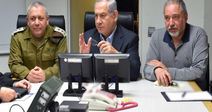
The Israeli Prime Minister Benjamin Netanyahu warned Sunday that Israel is preparing for the possibility of a new military operation in the Gaza Strip, Israeli media sources revealed.
“If the reality of civil distress in Gaza is diminished, that is desirable, but that is not certain to happen, and so we are preparing militarily — that is not an empty statement,” Netanyahu said during his cabinet meeting.
Palestinians in the Gaza Strip have entered their 11th year under a suffocating siege imposed by Israel. The blockade dictates the day-to-day reality for people in Gaza, where Israel controls the borders, airspace, and waters.
Gaza's isolation has devastated its economy, impoverished much of the Strip's two million people, and left them without adequate electricity, water and health services.
Netanyahu: Army Prepping for Possible Military Assault on Gaza
Israeli Prime Minister Benjamin Netanyahu has reportedly informed his cabinet that the army is preparing for a possible military campaign against the blockaded Gaza Strip, in the case that the situation was not improved, according to Israeli media.
“If the reality of civil distress in Gaza is diminished, that is desirable, but that is not certain to happen, and so we are preparing militarily — that is not an empty statement,” Netanyahu said.
For the past six months, Palestinians have been protesting on the border of Gaza as part of the “Great Return March” in which 190 Palestinians have been killed, 64 of whom were killed on the day the US moved its embassy from Tel Aviv to Jerusalem.
In 2014, Israel waged a devastating 51-day military onslaught on the Gaza Strip, in which more than 2,300 Palestinians were martyred and tens of thousands injured.
“If the reality of civil distress in Gaza is diminished, that is desirable, but that is not certain to happen, and so we are preparing militarily — that is not an empty statement,” Netanyahu said during his cabinet meeting.
Palestinians in the Gaza Strip have entered their 11th year under a suffocating siege imposed by Israel. The blockade dictates the day-to-day reality for people in Gaza, where Israel controls the borders, airspace, and waters.
Gaza's isolation has devastated its economy, impoverished much of the Strip's two million people, and left them without adequate electricity, water and health services.
Netanyahu: Army Prepping for Possible Military Assault on Gaza
Israeli Prime Minister Benjamin Netanyahu has reportedly informed his cabinet that the army is preparing for a possible military campaign against the blockaded Gaza Strip, in the case that the situation was not improved, according to Israeli media.
“If the reality of civil distress in Gaza is diminished, that is desirable, but that is not certain to happen, and so we are preparing militarily — that is not an empty statement,” Netanyahu said.
For the past six months, Palestinians have been protesting on the border of Gaza as part of the “Great Return March” in which 190 Palestinians have been killed, 64 of whom were killed on the day the US moved its embassy from Tel Aviv to Jerusalem.
In 2014, Israel waged a devastating 51-day military onslaught on the Gaza Strip, in which more than 2,300 Palestinians were martyred and tens of thousands injured.
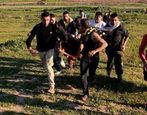
Israeli soldiers shot, overnight, one Palestinian with live fire, and caused many others to suffer the effects of teargas inhalation, in addition to invading farmlands, in several parts of the Gaza Strip.
Medical sources said the soldiers shot a young man with live fire, east of the al-Boreij refugee camp, in central Gaza, and caused many to suffer the effects of teargas inhalation, after the army attacked protesters on Palestinian lands near the fence.
The soldiers also attacked protesters with live fire and gas bombs, east of Gaza city, and east of Rafah, in the southern part of the coastal region.
In related news, five armored Israeli military bulldozers carried out a limited invasion into Palestinian lands, east of the al-Boreij refugee camp, in central Gaza, and bulldozed them.
Medical sources said the soldiers shot a young man with live fire, east of the al-Boreij refugee camp, in central Gaza, and caused many to suffer the effects of teargas inhalation, after the army attacked protesters on Palestinian lands near the fence.
The soldiers also attacked protesters with live fire and gas bombs, east of Gaza city, and east of Rafah, in the southern part of the coastal region.
In related news, five armored Israeli military bulldozers carried out a limited invasion into Palestinian lands, east of the al-Boreij refugee camp, in central Gaza, and bulldozed them.
7 oct 2018

An Israeli aircraft has attacked on Sunday evening a group of Palestinian protesters near the eastern border of the southern Gaza Strip.
Local sources affirmed that a group of demonstrators came under attack by an Israeli aircraft to the south of Rafah city.
The Israeli army claimed the demonstrators were firing fire balloons when its aircraft targeted them on Sunday evening.
No injuries were reported by the Palestinian Health Ministry.
The incident comes as fresh demonstrations are continued along the Gaza border on nearly daily basis.
On March 30, Gazans marched to the border fence at the start of a six-week protest, dubbed “The Great March of Return.”
The mass protest, however, turned violent when Israeli military forces used lethal force to disperse the crowd.
Local sources affirmed that a group of demonstrators came under attack by an Israeli aircraft to the south of Rafah city.
The Israeli army claimed the demonstrators were firing fire balloons when its aircraft targeted them on Sunday evening.
No injuries were reported by the Palestinian Health Ministry.
The incident comes as fresh demonstrations are continued along the Gaza border on nearly daily basis.
On March 30, Gazans marched to the border fence at the start of a six-week protest, dubbed “The Great March of Return.”
The mass protest, however, turned violent when Israeli military forces used lethal force to disperse the crowd.
6 oct 2018
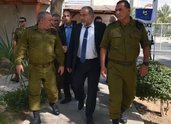
Israel's War Minister Avigdor Lieberman on Saturday ordered the reduction of the Gaza Strip's fishing zone.
Hebrew media sources reported that Lieberman ordered the Israeli army to curtail the fishing zone from 9 to 6 nautical miles following security consultations with Israeli officials.
Lieberman, in the wake of Gaza border protests on Friday, threatened Hamas to escalate the punitive measures against the Gaza Strip after the end of Jewish holidays.
Palestinians in the Gaza Strip have been suffering from a crippling sea blockade for over a decade now.
Hebrew media sources reported that Lieberman ordered the Israeli army to curtail the fishing zone from 9 to 6 nautical miles following security consultations with Israeli officials.
Lieberman, in the wake of Gaza border protests on Friday, threatened Hamas to escalate the punitive measures against the Gaza Strip after the end of Jewish holidays.
Palestinians in the Gaza Strip have been suffering from a crippling sea blockade for over a decade now.
5 oct 2018
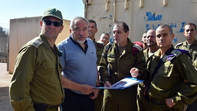
'We got through the High Holy Days just as we had planned, without a war erupting and while exacting a heavy price from the rioters on the Gaza border,' says defense minister, hinting at Israeli response now that holidays are over.
Defense Minister Avigdor Lieberman sent a warning to Hamas on Friday morning, writing on his Twitter page that "the holidays are behind us, take that into account."
"We got through the High Holy Days just as we had planned, without a war erupting and while exacting a heavy price from the rioters on the Gaza border," Lieberman wrote. "But the holidays are now behind us, and I tell the heads of Hamas: 'Take that into account.'"
The defense minister held security consultations on Thursday with the IDF chief of staff, the head of the Military Intelligence Directorate, the coordinator of government activities in the territories (COGAT) and other senior defense officials to discuss the situation in Gaza.
"The defense minister examined the readiness of the forces around the Gaza Strip and instructed the IDF to maintain maximum alertness and be prepared for any scenario," Lieberman's office said.
IDF Chief of Staff Gadi Eisenkot decided Thursday to send reinforcements to the Gaza border in the coming days.
The IDF said in a statement that the decision was made "to continue the determined policy to thwart terror attacks and prevent infiltrations into Israel in the border fence area of the Gaza Strip. The IDF is prepared and ready for a variety of scenarios and considers the Hamas terror organization responsible for everything that happens in and from the Gaza Strip."
Ahead of the expected rioting on the Gaza border on Friday, the Popular Resistance Committees in the strip threatened Thursday that "blood will be met with blood" and that "We will no longer tolerate the killing of protesters."
The Al-Quds Brigades, the Palestinian Islamic Jihad's military wing, held a military parade in the Gaza Strip Thursday, displaying what was either real or dummy rockets.
A 15-year-old Palestinian teen was shot dead Wednesday evening during clashes between Palestinian rioters and IDF forces near the Erez border crossing in the northern Gaza Strip.
Over a 1,000 Palestinians protested in several different spots along the border fence, throwing stones at IDF forces and setting fire to tires.
The Israeli troops responded with crowd dispersal measures, with the IDF saying the soldiers "are acting in accordance with the rules of engagement."
Meanwhile, a Hamas delegation headed by the terror group's deputy leader Saleh al-Arouri returned Wednesday after four days of discussions in Cairo with top Egyptian intelligence officials.
The discussions revolved around both the reconciliation with Fatah—a rival Palestinian faction led by Mahmoud Abbas—and an arrangement in Gaza, which would include a ceasefire agreement with Israel. It is unclear what the outcome of these discussions was.
In recent weeks, there has been a spike in Palestinian rioting in Gaza, as well as in the launch of incendiary balloons and kites.
On Monday, some 4,000 Palestinians rioted in northern Gaza, throwing stones and Molotov cocktails and launching fireworks at Israeli forces, who responded with crowd dispersal measures.
Defense Minister Avigdor Lieberman sent a warning to Hamas on Friday morning, writing on his Twitter page that "the holidays are behind us, take that into account."
"We got through the High Holy Days just as we had planned, without a war erupting and while exacting a heavy price from the rioters on the Gaza border," Lieberman wrote. "But the holidays are now behind us, and I tell the heads of Hamas: 'Take that into account.'"
The defense minister held security consultations on Thursday with the IDF chief of staff, the head of the Military Intelligence Directorate, the coordinator of government activities in the territories (COGAT) and other senior defense officials to discuss the situation in Gaza.
"The defense minister examined the readiness of the forces around the Gaza Strip and instructed the IDF to maintain maximum alertness and be prepared for any scenario," Lieberman's office said.
IDF Chief of Staff Gadi Eisenkot decided Thursday to send reinforcements to the Gaza border in the coming days.
The IDF said in a statement that the decision was made "to continue the determined policy to thwart terror attacks and prevent infiltrations into Israel in the border fence area of the Gaza Strip. The IDF is prepared and ready for a variety of scenarios and considers the Hamas terror organization responsible for everything that happens in and from the Gaza Strip."
Ahead of the expected rioting on the Gaza border on Friday, the Popular Resistance Committees in the strip threatened Thursday that "blood will be met with blood" and that "We will no longer tolerate the killing of protesters."
The Al-Quds Brigades, the Palestinian Islamic Jihad's military wing, held a military parade in the Gaza Strip Thursday, displaying what was either real or dummy rockets.
A 15-year-old Palestinian teen was shot dead Wednesday evening during clashes between Palestinian rioters and IDF forces near the Erez border crossing in the northern Gaza Strip.
Over a 1,000 Palestinians protested in several different spots along the border fence, throwing stones at IDF forces and setting fire to tires.
The Israeli troops responded with crowd dispersal measures, with the IDF saying the soldiers "are acting in accordance with the rules of engagement."
Meanwhile, a Hamas delegation headed by the terror group's deputy leader Saleh al-Arouri returned Wednesday after four days of discussions in Cairo with top Egyptian intelligence officials.
The discussions revolved around both the reconciliation with Fatah—a rival Palestinian faction led by Mahmoud Abbas—and an arrangement in Gaza, which would include a ceasefire agreement with Israel. It is unclear what the outcome of these discussions was.
In recent weeks, there has been a spike in Palestinian rioting in Gaza, as well as in the launch of incendiary balloons and kites.
On Monday, some 4,000 Palestinians rioted in northern Gaza, throwing stones and Molotov cocktails and launching fireworks at Israeli forces, who responded with crowd dispersal measures.
Abu Sama'an, 24, were fatally shot during “The Great March of Return” protests east of Gaza City.
Hussein Fathi al-Raqab, 28, succumbed also to his Israeli-inflicted gunshot wounds at the Nasser Medical Complex. He had been shot and injured during a demonstrators east of the city of Khan Yunis, located about 25 kilometers south of Gaza City.
The statement added that another 376 protesters were also injured. A total of 192 demonstrators were admitted to hospitals and medical centers across Gaza Strip to receive medical treatment.
It further noted that 126 people were struck with live bullets. Seven wounded protesters are said to be in a critical condition in hospital.
Qidra went on to say that Israeli military forces directly targeted a Palestinian ambulance with a gas grenade east of Gaza, without causing any casualties.
Journalist Mohammed Hazem al-Masri suffered injuries when a tear gas canister hit him in the head east of Jabalia refugee camp.
Nearly 200 Palestinians have been killed by Israeli forces ever since anti-occupation protest rallies began in the Gaza Strip on March 30. Over 21,600 Palestinians have also sustained injuries.
The Gaza clashes reached their peak on May 14, on the eve of the 70th anniversary of Nakba Day (Day of Catastrophe), which coincided this year with the US embassy relocation from Tel Aviv to occupied East Jerusalem al-Quds.
On June 13, the United Nations General Assembly adopted a resolution, sponsored by Turkey and Algeria, condemning Israel for Palestinian civilian deaths in the Gaza Strip.
The resolution, which had been put forward on behalf of Arab and Muslim countries, garnered a strong majority of 120 votes in the 193-member assembly, with 8 votes against and 45 abstentions.
The resolution called on UN Secretary General Antonio Guterres to make proposals within 60 days “on ways and means for ensuring the safety, protection, and well-being of the Palestinian civilian population under Israeli occupation,” including “recommendations regarding an international protection mechanism.”
It also called for “immediate steps towards ending the closure and the restrictions imposed by Israel on movement and access into and out of the Gaza Strip.” video video
Hussein Fathi al-Raqab, 28, succumbed also to his Israeli-inflicted gunshot wounds at the Nasser Medical Complex. He had been shot and injured during a demonstrators east of the city of Khan Yunis, located about 25 kilometers south of Gaza City.
The statement added that another 376 protesters were also injured. A total of 192 demonstrators were admitted to hospitals and medical centers across Gaza Strip to receive medical treatment.
It further noted that 126 people were struck with live bullets. Seven wounded protesters are said to be in a critical condition in hospital.
Qidra went on to say that Israeli military forces directly targeted a Palestinian ambulance with a gas grenade east of Gaza, without causing any casualties.
Journalist Mohammed Hazem al-Masri suffered injuries when a tear gas canister hit him in the head east of Jabalia refugee camp.
Nearly 200 Palestinians have been killed by Israeli forces ever since anti-occupation protest rallies began in the Gaza Strip on March 30. Over 21,600 Palestinians have also sustained injuries.
The Gaza clashes reached their peak on May 14, on the eve of the 70th anniversary of Nakba Day (Day of Catastrophe), which coincided this year with the US embassy relocation from Tel Aviv to occupied East Jerusalem al-Quds.
On June 13, the United Nations General Assembly adopted a resolution, sponsored by Turkey and Algeria, condemning Israel for Palestinian civilian deaths in the Gaza Strip.
The resolution, which had been put forward on behalf of Arab and Muslim countries, garnered a strong majority of 120 votes in the 193-member assembly, with 8 votes against and 45 abstentions.
The resolution called on UN Secretary General Antonio Guterres to make proposals within 60 days “on ways and means for ensuring the safety, protection, and well-being of the Palestinian civilian population under Israeli occupation,” including “recommendations regarding an international protection mechanism.”
It also called for “immediate steps towards ending the closure and the restrictions imposed by Israel on movement and access into and out of the Gaza Strip.” video video

Mahmoud Abu Samaan 24
Fares al-Sersawi, 12
At least two Palestinians were killed Friday by Israeli army gunfire -- and another 126 injured -- amid ongoing demonstrations along the Gaza-Israel buffer zone.
In a statement, Ashraf al-Qidra, a spokesman for Gaza’s Health Ministry, said that one of the two martyrs -- neither of whom has yet been identified -- was a minor.
According to al-Qidra, “dozens” of Palestinian protesters were affected by teargas while 126 others, including 10 women and 30 children, sustained gunshot injuries.
Seven of the injured persons were in serious condition, he added.
Demonstrators demand the “right of return” to their homes and villages in historical Palestine from which they were driven in 1948 to make way for the new state of Israel.
They also demand an end to Israel’s 11-year blockade of the Gaza Strip, which has gutted the coastal enclave’s economy and deprived its two million inhabitants of many basic commodities.
According to the Health Ministry, more than 190 Palestinians have been martyred -- and 20,000 others injured -- since the rallies first began on March 30.
Fares al-Sersawi, 12
At least two Palestinians were killed Friday by Israeli army gunfire -- and another 126 injured -- amid ongoing demonstrations along the Gaza-Israel buffer zone.
In a statement, Ashraf al-Qidra, a spokesman for Gaza’s Health Ministry, said that one of the two martyrs -- neither of whom has yet been identified -- was a minor.
According to al-Qidra, “dozens” of Palestinian protesters were affected by teargas while 126 others, including 10 women and 30 children, sustained gunshot injuries.
Seven of the injured persons were in serious condition, he added.
Demonstrators demand the “right of return” to their homes and villages in historical Palestine from which they were driven in 1948 to make way for the new state of Israel.
They also demand an end to Israel’s 11-year blockade of the Gaza Strip, which has gutted the coastal enclave’s economy and deprived its two million inhabitants of many basic commodities.
According to the Health Ministry, more than 190 Palestinians have been martyred -- and 20,000 others injured -- since the rallies first began on March 30.
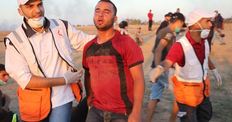
The Israeli army at nightfall Thursday hit a mobile clinic near Gaza’s border fence with a shell, the Palestinian Health Ministry has reported.
Spokesman for the Gaza-based Palestinian Health Ministry said the Israeli occupation forces dropped a mortar into a makeshift clinic in Khuza’a town, east of Khan Younis province, south of Gaza.
Heavy material damage was reportedly inflicted by the strike.
Since the start of the Great March of Return protests, on March 30, Makeshift clinics have been set up by Palestinians along the Gaza border to tend to civilians, medical staff members, and journalists injured by Israeli soldiers.
The protests have been staged to speak up for Palestinians’ right to return to their motherland—Palestine—from which they have been forcibly deported by the Israeli occupation.
Spokesman for the Gaza-based Palestinian Health Ministry said the Israeli occupation forces dropped a mortar into a makeshift clinic in Khuza’a town, east of Khan Younis province, south of Gaza.
Heavy material damage was reportedly inflicted by the strike.
Since the start of the Great March of Return protests, on March 30, Makeshift clinics have been set up by Palestinians along the Gaza border to tend to civilians, medical staff members, and journalists injured by Israeli soldiers.
The protests have been staged to speak up for Palestinians’ right to return to their motherland—Palestine—from which they have been forcibly deported by the Israeli occupation.
Page: 50 - 49 - 48 - 47 - 46 - 45 - 44 - 43 - 42 - 41 - 40 - 39 - 38 - 37 - 36 - 35 - 34 - 33 - 32 - 31 - 30 - 29
